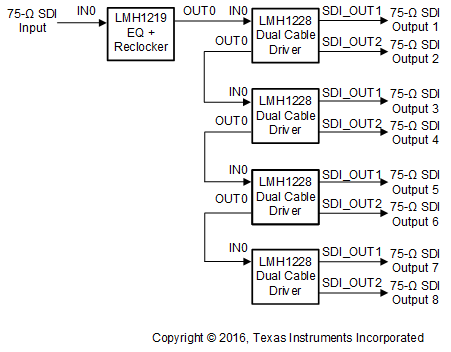SNLS568D March 2017 – May 2020 LMH1228
PRODUCTION DATA.
- 1 Features
- 2 Applications
- 3 Description
- 4 Revision History
- 5 Pin Configuration and Functions
- 6 Specifications
-
7 Detailed Description
- 7.1 Overview
- 7.2 Functional Block Diagram
- 7.3
Feature Description
- 7.3.1 4-Level Input Pins and Thresholds
- 7.3.2 OUT0_SEL and SDI_OUT2_SEL Control
- 7.3.3 Input Signal Detect
- 7.3.4 Continuous Time Linear Equalizer (CTLE)
- 7.3.5 Clock and Data (CDR) Recovery
- 7.3.6 Internal Eye Opening Monitor (EOM)
- 7.3.7 Output Function Control
- 7.3.8 Output Driver Control
- 7.3.9 Status Indicators and Interrupts
- 7.4 Device Functional Modes
- 7.5 Register Maps
- 8 Application and Implementation
- 9 Power Supply Recommendations
- 10Layout
- 11Device and Documentation Support
- 12Mechanical, Packaging, and Orderable Information
Package Options
Mechanical Data (Package|Pins)
- RTV|32
Thermal pad, mechanical data (Package|Pins)
- RTV|32
Orderable Information
8.2.2 Distribution Amplifier
The LMH1228 can be configured as a distribution amplifier to distribute the same SDI input signal to multiple cable driver outputs. In this configuration, the LMH1228 uses the dual cable drivers at SDI_OUT1 and SDI_OUT2 to drive out the SDI signal seen at IN0. Meanwhile, the loop-back output on OUT0 is daisy-chained as a duplicate input to IN0 of the next LMH1228.
Figure 34 shows a typical application where four LMH1228s are used in combination with an LMH1219 Cable EQ with Integrated Reclocker to form a 1:8 distribution amplifier network.
 Figure 34. LMH1228 Distribution Amplifier Application
Figure 34. LMH1228 Distribution Amplifier Application